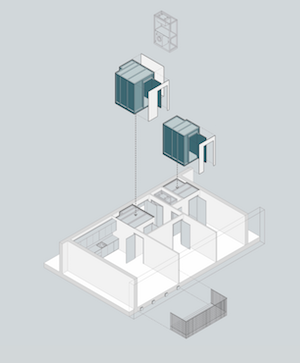A new digital toolkit that aims to save time and costs for the affordable housing sector is under development by an L&Q-led consortium. Denise Chevin asks: is it the missing link in encouraging the uptake of MMC?
A housing association-led project is aiming to speed up the design of construction of new homes in the affordable housing sector by as much as 30% with the development of a digital toolkit that will make it easier to use standard components for housing delivery.
Benefitting from Innovate UK funding, a partnership – the COLAB consortium – led by L&Q (alongside Virtual Viewing, Hawkins\Brown Architects and HTA Design) has set out to develop a digital Design for Manufacture and Assembly (DfMA) toolkit.
The software will make it easier to deliver new homes using modern methods of construction by creating a central database within which standard components can be stored and selected. These standard components would include building elements including bathroom pods, utility cupboards and balcony pods, as well as entire apartment layouts, and ensure housing associations think about how the homes will be built from the outset.
Lanre Gbolade, production innovation lead at L&Q, says the toolkit could bring enormous benefits: “We anticipate this project’s outcomes to provide an organisation like L&Q with 30% reduction in design and construction programmes and 25% increase in return on capital employed if applied across its development programme.” L&Q says that delivered to the wider housing market and scaled, this approach could provide enormous savings.

We anticipate this project’s outcomes to provide a 30% reduction in design and construction programmes and 25% increase in return on capital employed.– Lanre Gbolade, L&Q
15 months of development
L&Q is one of the UK’s leading charitable housing associations and developers, and in 2018/2019 completed 2,862 homes, and has a development pipeline of 50,400 homes, with 16,000 on site. The use of MMC is currently limited to developments outside the capital, where it is in a joint venture with Stewart Milne, explains Gbolade. But the plan is to move incrementally towards an increasing use of MMC over the next 10 years. “What we have been doing for the last two years is focussing on R&D and developing that roadmap. The DfMA toolkit is part of that transition.”
L&Q, Hawkins\Brown and HTA came up with the idea a couple of years ago. Winning government funding has allowed them to take it forward, with Virtual Viewing coming on board to design and configure an easy to use, graphic interface for the app. The 15-month programme is being part-funded by Innovate UK under the recently awarded Transforming UK Construction Round 2: MMC, Digital and Whole-Life Performance competition.
The team is aiming to have the toolkit ready by June 2021. When completed in June 2021, COLAB will partner with housing associations, local authorities and housebuilders to roll it out.
The idea was forged out of the need for the sector to start thinking differently to supply the homes needed.
“We have this target of 300,000 new homes a year,” says Nigel Ostime, delivery director of Hawkins\Brown, “but there is no way we can achieve it using traditional means. On average, the UK has built around 155,000 homes per year over the last 30 years. It’s clear we need a smarter way of building, which will involve the greater use of MMC and digital technology.”

We’ve got to stop doing this: as architects, we’re adding no value by redesigning a bathroom from scratch every time, so let’s accept that there is a good bathroom model already.– Nigel Ostime, Hawkins\Brown
It should, he says, also overcome barriers to using MMC by encouraging housing associations to think about the building process early. “Too often clients only think about using offsite construction once the design has been drawn up. Yet the benefits of offsite then can’t be realised, and it often works out more expensive than traditional construction,” he explains.
Both men are keen to emphasise that using standardised components and layouts is not about every home looking the same. “To make modern methods of construction efficient, you need scale, but you have to strike a balance between providing a good amount of variation in the end product, but having standardisation in the core,” says Gbolade.
“It will also bring efficiency to the design process, which is important,” adds Ostime. “We did quite an extensive piece of research into looking at around 1,700 pre-existing schemes that L&Q had, that we had, that others in the team had. And we discovered that across those schemes there were only very small variations in the size of bathrooms – but all were different.
“We’ve got to stop doing this: as architects, we’re adding no value by redesigning a bathroom from scratch every time, so let’s accept that there is a good bathroom model already.
“We can change the finishes and to some extent we can change the fittings, but we’ve got to standardise the core product.
“The designer’s time is better spent producing value in terms of the user experience, which will be to do with fittings and finishes within the apartment, along with the response to the site, and of course the external materials.”

BIM at its heart
HTA and Hawkins\Brown are building up L&Q standard layouts and component types drawn up in Revit models, that L&Q development and sales teams will be able to call on from the toolkit’s database.
“Think of it as a central portal that gives access to design information and 3D model information that can be used by project teams in developing their design and allows them to select the products or components (balconies, bathrooms, whole apartments) from a set of standard ‘products’. But its potential is far wider and could cover the whole cradle to grave process for an entire portfolio of buildings,” explains Ostime.
It will also demonstrate, through an easy-to-navigate user interface, how to go about using the tool and its components to develop the building design and then potentially to also manage the built asset.
“It could also be used for sales and marketing and for general internal communication across the organisation. This is important in itself in the drive for standardisation,” he says.
The BIM families have sufficient detail and meta data to directly procure manufacturers/suppliers and/or contractors. COLAB is opting for RIBA Stage 4, but they could be whatever level wanted by the organisation using it.
When completed, the consortium will engage with industry to encourage others to benefit from the toolkit, says Gbolade. Each housing provider that wants to use it will need to populate it with their own ‘products’ and manage the tool, explains Ostime.
Comments
Comments are closed.












Will this piece of work relate to the existing study undertaken by bryden wood a year earlier?